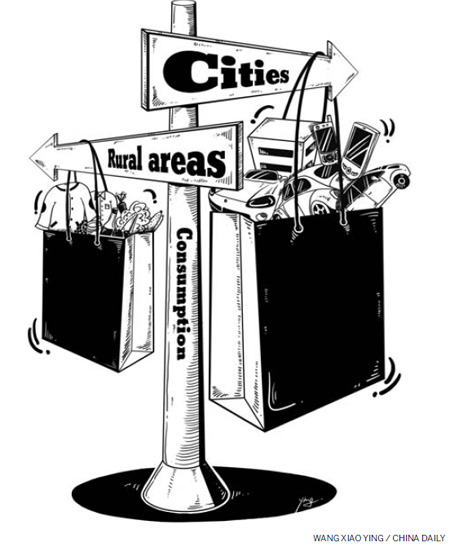Opinion
Domestic market for economic bliss
By Syetarn Hansakul (China Daily)
Updated: 2010-10-08 14:39
 |
Large Medium Small |
China could overtake Japan as the world's second largest consumer market in the next decade. Its private consumption today is only about 16 percent and 56 percent of that in the United States and Japan. But China's strong GDP growth outlook bodes well for its domestic consumers, since it goes together with an increase in per capita income and the attainment of consumption thresholds.
Moreover, the Chinese government has an array of active policies oriented toward increasing disposable income and rebalancing its growth model toward domestic demand.
Many Western consumer and luxury brands have expanded into China after the global financial crisis struck, and have reported brisk sales, with some posting double-digit growth even during the global recession last year. One of the most concrete examples of this can be found in the automobile industry.
China overtook the US as the world's largest automobile market last year, with vehicle sales reaching 13.6 million units, compared with 10.4 million cars and light trucks sold in the US. Many of these products have penetrated only the high-income group of urban households. The potential of other groups such as the high-income group in rural areas and middle-income group in urban areas is yet to be fully explored.
Official data show the number of registered households in cities was 192.4 million in 2008, about 46 percent of the total registered households (403.8 million). This mirrors the ratio of urban to rural population. The rural population actually shrank from 796 million in 1980 to 713 million last year.
In terms of annual household income, about 22 percent of China's urban households - or about 43 million urban households - had an annual income of about 65,000 yuan ($9,714.5) or above in 2008, rising from only 7.8 percent in 2005. Their number is likely to be close to 50 million currently. As such, this consumer segment is comparable to medium-sized, high-income Asian economies such as South Korea.
Data on consumer goods ownership show solid growth across all key products in the past decade, with the only exception being fixed-line telephones. Ownership of washing machines and refrigerators appear to be nearing the saturation mark. Automobiles have a lot of headroom ahead because the ownership level is still relatively low at 10.5 cars per 100 urban households. Mobile phones have seen an explosive growth from 3.3 phones per 100 urban households in 1998 to 180 phones in September 2009.
Compared to the early 1990s, when data on consumption expenditure baskets became first available, consumption patterns have shown a shift away from basic necessities such as food, clothing and household appliances toward transport, residence and recreation.
Rural households used to be a major contributor to nominal GDP in previous decades. But their contribution has declined in importance. At present, they contribute about 9 percent of nominal GDP, a steady decline from 24 percent in 1990. This contrasts with the contribution of urban household consumption, about 26 percent of nominal GDP at present, which is roughly unchanged from 25-30 percent in the 1990s.
On average, per capita rural household income rose 12 percent from 1987 to 2009, slower than the 15 percent growth of urban households. This means that the gap in rural-urban per capita income increased over time, especially after 2001. The trend has intensified because of a more rapid rate of urbanization.
All rural income groups, just like their urban counterparts, spend the largest percentage of their income on food. Data on rural consumption only goes back to 2002. Since then, the pattern of consumption by rural consumers has been more uniform than urban consumption, and has concentrated on food, residence and transport. Not surprisingly, rural consumers do not spend as much as their urban counterparts on discretionary items such as recreation or clothing.
As is to be expected, rural residents lag behind their urban counterparts when it comes to consumer goods ownership. This indicates that there is still a lot of headroom for growth of consumer products' sales in rural areas.
The items that have seen the strongest growth in recent years are mobile phones, which rose from 4 per 100 households in 2000 to 115 in 2009, followed by color TV sets - from 49 per 100 households to 109. The ownership of household appliances such as washing machines, refrigerators and air conditioners, as well as motorcycles, is still low among rural households compared to their urban counterparts. Motorcycle ownership is about 57 per 100 households, even though it has more than doubled from 22 in 2000.
Farming will remain the most important source of income for rural families even in the foreseeable future, and there is plenty of scope to improve income from farming. Since most farming activities in China are small-scale and family-based, the central government has undertaken a major policy initiative to develop modern agricultural production, which should improve productivity and raise rural income. The recent focus on improving agricultural infrastructure, including water sources and irrigation facilities is encouraging.
Putting aside the potential impact of structural policies to increase urban and rural household income, the continuation of current growth trends is likely to create two powerful groups of consumers in China in the next decade. Urban consumers will expand both in size and spending power and their spending behavior will increasingly resemble consumers in the high-income Asian economies such as Japan, Singapore and South Korea, and Hong Kong. This bodes well for many industries, including travel, automobile, real estate, luxury goods and information/communication equipment.
As incomes rise in rural China, its spending behavior will be similar to lower middle-income economies in Asia, which should boost the market for consumer staple goods and generate a second pole of private consumption on which China's economy can rely.
The author is a senior economist at Deutsche Bank.
|
 |




